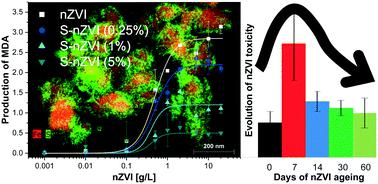当前位置:
X-MOL 学术
›
Environ. Sci.: Nano
›
论文详情
Our official English website, www.x-mol.net, welcomes your feedback! (Note: you will need to create a separate account there.)
Environmental fate of sulfidated nZVI particles: the interplay of nanoparticle corrosion and toxicity during aging
Environmental Science: Nano ( IF 7.3 ) Pub Date : 2020-04-23 , DOI: 10.1039/d0en00075b Jaroslav Semerád 1, 2, 3, 4, 5 , Jan Filip 3, 6, 7, 8 , Alena Ševců 3, 9, 10, 11 , Miroslav Brumovský 3, 6, 7, 8 , Nhung H. A. Nguyen 3, 9, 10, 11 , Jiří Mikšíček 3, 9, 10, 11 , Tomáš Lederer 3, 9, 10, 11 , Alena Filipová 1, 2, 3, 4, 5 , Jana Boháčková 1, 2, 3, 4, 5 , Tomáš Cajthaml 1, 2, 3, 4, 5
Environmental Science: Nano ( IF 7.3 ) Pub Date : 2020-04-23 , DOI: 10.1039/d0en00075b Jaroslav Semerád 1, 2, 3, 4, 5 , Jan Filip 3, 6, 7, 8 , Alena Ševců 3, 9, 10, 11 , Miroslav Brumovský 3, 6, 7, 8 , Nhung H. A. Nguyen 3, 9, 10, 11 , Jiří Mikšíček 3, 9, 10, 11 , Tomáš Lederer 3, 9, 10, 11 , Alena Filipová 1, 2, 3, 4, 5 , Jana Boháčková 1, 2, 3, 4, 5 , Tomáš Cajthaml 1, 2, 3, 4, 5
Affiliation

|
Nanomaterials have attracted research attention due to their unique properties, which have also made them increasingly useful for various applications, including remediation technologies. In this work, we tried to explore the aging phenomenon of several newly developed nanoscale zero-valent iron (nZVI) particles containing 0.25, 1, and 5% sulfur and to monitor the possible toxicity changes related to the nZVI particles before and during the aging period. We used several relevant techniques for monitoring nZVI aging, including transmission electron microscopy, X-ray powder diffraction, and particle size analysis. The toxicity of the nZVI particles was monitored using a new oxidative stress assay based on lipid peroxidation, a simple bacterial cultivation test. A test using activated sludge respiration and phospholipid fatty acid analysis of microbial populations was also employed. The results of the material analyses showed that the sulfidated nZVI particles were more stable than bare nZVI particles in terms of Fe0 content and particle diameter. The stability was more pronounced with the increasing content of sulfur in the nanoparticles; the content of α-Fe was only 35.3% in the nZVI particles compared with 78.6% in the 5% sulfur-doped nanoparticles after 60 days of aging. The results of the oxidative stress assay revealed that the toxicity was also lower with increasing sulfur content; nevertheless, the oxidative stress marker increased substantially after 7 days of aging, reaching a similar level to that caused by bare nZVI in some cases. Other results showed that even incubation in media used for the respective tests caused extensive aging; therefore, this information must be considered before the selection of toxicity assays for nanomaterial evaluation.
中文翻译:

硫化nZVI颗粒的环境命运:老化过程中纳米颗粒腐蚀与毒性的相互作用
纳米材料由于其独特的性能而吸引了研究的注意力,这也使其在包括修复技术在内的各种应用中越来越有用。在这项工作中,我们尝试探索几种新开发的含0.25、1和5%硫的纳米级零价铁(nZVI)颗粒的老化现象,并监测老化之前和期间与nZVI颗粒相关的可能的毒性变化期。我们使用了几种相关技术来监测nZVI的老化,包括透射电子显微镜,X射线粉末衍射和粒度分析。使用基于脂质过氧化的新氧化应激测定法(一种简单的细菌培养测试),可以监测nZVI颗粒的毒性。还使用了利用活性污泥呼吸和微生物群体的磷脂脂肪酸分析进行的测试。材料分析结果表明,硫化的nZVI颗粒比裸露的nZVI颗粒更稳定0含量和粒径。随着纳米颗粒中硫含量的增加,稳定性更加明显。老化60天后,nZVI颗粒中的α-Fe含量仅为35.3%,而5%硫掺杂的纳米颗粒中为78.6%。氧化应激试验的结果表明,毒性随着硫含量的增加而降低。然而,老化7天后,氧化应激标记物显着增加,在某些情况下达到了与裸露的nZVI相似的水平。其他结果表明,即使在用于各个测试的培养基中孵育也会导致大量老化。因此,在选择用于纳米材料评估的毒性试验之前,必须考虑这些信息。
更新日期:2020-06-18
中文翻译:

硫化nZVI颗粒的环境命运:老化过程中纳米颗粒腐蚀与毒性的相互作用
纳米材料由于其独特的性能而吸引了研究的注意力,这也使其在包括修复技术在内的各种应用中越来越有用。在这项工作中,我们尝试探索几种新开发的含0.25、1和5%硫的纳米级零价铁(nZVI)颗粒的老化现象,并监测老化之前和期间与nZVI颗粒相关的可能的毒性变化期。我们使用了几种相关技术来监测nZVI的老化,包括透射电子显微镜,X射线粉末衍射和粒度分析。使用基于脂质过氧化的新氧化应激测定法(一种简单的细菌培养测试),可以监测nZVI颗粒的毒性。还使用了利用活性污泥呼吸和微生物群体的磷脂脂肪酸分析进行的测试。材料分析结果表明,硫化的nZVI颗粒比裸露的nZVI颗粒更稳定0含量和粒径。随着纳米颗粒中硫含量的增加,稳定性更加明显。老化60天后,nZVI颗粒中的α-Fe含量仅为35.3%,而5%硫掺杂的纳米颗粒中为78.6%。氧化应激试验的结果表明,毒性随着硫含量的增加而降低。然而,老化7天后,氧化应激标记物显着增加,在某些情况下达到了与裸露的nZVI相似的水平。其他结果表明,即使在用于各个测试的培养基中孵育也会导致大量老化。因此,在选择用于纳米材料评估的毒性试验之前,必须考虑这些信息。



























 京公网安备 11010802027423号
京公网安备 11010802027423号